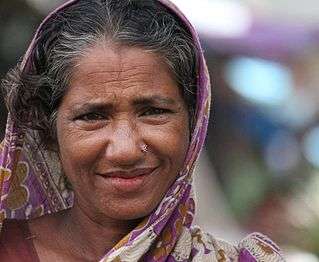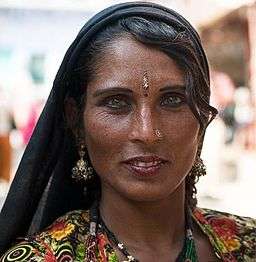Nose-jewel

A nose-jewel is a piece of jewelry that is worn on the nose.
Most commonly associated with women from the Indian subcontinent, these ornaments, are attached through a piercing on the side of the nostril. Because of globalization and the spread of Indian fashion and culture, nostril piercing has in recent decades become popular in the wider world and small gems or studs carried on a piercing have also become fashionable for (mostly) young women in other parts of the world including the Americas, Japan, Europe in recent years.
In India
Double nose gems are common amongst South Indian, Pasthun, Punjabi, Rajastani and Nepali ethnic groups. These are called 'nathori' and were depicted over 5,000 years ago through Goddess Parvati and Lord Krishna. In Maharashtra women wear one large nathori covering the side of the face. Bengali women prefer the septum piercing showing a sign of marriage.
Nose ring, called nath (Hindi: नथ, IPA: [nt̪ʰ]) in various Indian languages, became popular in 9th and 10th century and became part of various symbols of marital status of women. It also showcased economic status; wives of kings, ministers and wealthy families wearing nath made of pearls, sapphire and kundan while others wearing those made in silver. Towards 15th century, the ornament became quite popular and saw variations of using clove, thorns, nails during 17th-18th century. Modern nose rings with contemporary materials and designs came in 20th century.[1]
Reference in the Bible
In the Bible, nose-jewels are mentioned in Isaiah 3:21, and referred to in Ezekiel 16:12, Genesis 24:47, Proverbs 11:22, and Hosea 2:13. They were among the most valued of female ornaments. They were made of ivory or metal, occasionally jewelled, more than an inch in diameter, and hung upon the mouth. Eliezer gave one to Rebekah which was gold and weighed half a shekel.
Nose Jewelry in Indian subcontinent
 Indian bride
Indian bride Indian Bridal Jewellery Set
Indian Bridal Jewellery Set lady in bangladesh
lady in bangladesh Indian Bridal Jewellery Set
Indian Bridal Jewellery Set beautiful woman in bangladesh
beautiful woman in bangladesh woman in rural Bangladesh
woman in rural Bangladesh Bride in Indian Subcontinent
Bride in Indian Subcontinent woman
woman bride
bride model
model jewelry
jewelry
See also
References
- ↑ Shanti Kumar Syal (2005). Pragatiśīla nārī (in Hindi). Delhi, India: Atmaram & Sons. p. 171. ISBN 9788170436478.
-
 This article incorporates text from a publication now in the public domain: Easton, Matthew George (1897). "article name needed". Easton's Bible Dictionary (New and revised ed.). T. Nelson and Sons.
This article incorporates text from a publication now in the public domain: Easton, Matthew George (1897). "article name needed". Easton's Bible Dictionary (New and revised ed.). T. Nelson and Sons.
| Wikimedia Commons has media related to Nose rings. |